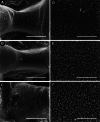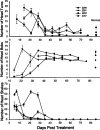Posture, head stability, and orientation recovery during vestibular regeneration in pigeons
- PMID: 15492889
- PMCID: PMC2504555
- DOI: 10.1007/s10162-004-4047-0
Posture, head stability, and orientation recovery during vestibular regeneration in pigeons
Abstract
Compensatory behavior such as oculomotor, gaze, and postural responses that occur during movement largely depend upon a functioning vestibular system. In the present study, the initial loss and subsequent recovery of postural and head stability in pigeons undergoing vestibular regeneration were examined. Adult pigeons were trained to manipulate a straight run chamber to peck an illuminated key for fluid reward. Six behavioral measures assessing performance, posture, and head stability were quantified. These included run latency, steps (walking), path negotiation (lane changes), gaze saccades, head bobs, and head shakes. Once normative values were obtained for four birds, complete lesion of all receptor cells and denervation of the epithelia in the vestibular endorgans were produced using a single intralabyrinthine application of streptomycin sulfate. Each bird was then tested at specific times during regeneration and the same behavioral measures examined. At 7 days post-streptomycin treatment (PST), all birds exhibited severe postural and head instability, with tremors, head shakes, staggering, and circling predominating. No normal trial runs, walking, gaze saccades, or head bobs were present. Many of these dysfunctions persisted through 3-4 weeks PST. Gradually, tremor and head shakes diminished and were replaced with an increasing number of normal head bobs during steps and gaze saccades. Beginning at 4 weeks PST, but largely inaccurate, was the observed initiation of directed steps, less staggering, and some successful path negotiation. As regeneration progressed, spatial orientation and navigation ability increased and, by 49 days PST, most trials were successful. By 70 days PST, all birds had recovered to pretreatment levels. Thus, it was observed that ataxia must subside, coincident with normalized head and postural stability prior to the recovery of spatial orientation and path navigation recovery. Parallels in recovery were drawn to hair cell regeneration and afferent responsiveness, as inferred from present results and those in other investigations.
Figures





Similar articles
-
Regeneration of vestibular otolith afferents after ototoxic damage.J Neurosci. 2006 Mar 15;26(11):2881-93. doi: 10.1523/JNEUROSCI.3903-05.2006. J Neurosci. 2006. PMID: 16540565 Free PMC article.
-
Recovery of gaze stability during vestibular regeneration.J Neurophysiol. 2008 Feb;99(2):853-65. doi: 10.1152/jn.01038.2007. Epub 2007 Nov 28. J Neurophysiol. 2008. PMID: 18045999
-
Distribution and time course of hair cell regeneration in the pigeon utricle.Hear Res. 1999 Jul;133(1-2):17-26. doi: 10.1016/s0378-5955(99)00046-5. Hear Res. 1999. PMID: 10416861
-
Neck afferent involvement in cardiovascular control during movement.Brain Res Bull. 2000 Sep 1;53(1):45-9. doi: 10.1016/s0361-9230(00)00307-5. Brain Res Bull. 2000. PMID: 11033207 Review.
-
Vestibulo-ocular physiology underlying vestibular hypofunction.Phys Ther. 2004 Apr;84(4):373-85. Phys Ther. 2004. PMID: 15049730 Review.
Cited by
-
Development and regeneration of vestibular hair cells in mammals.Semin Cell Dev Biol. 2017 May;65:96-105. doi: 10.1016/j.semcdb.2016.11.001. Epub 2016 Nov 15. Semin Cell Dev Biol. 2017. PMID: 27864084 Free PMC article. Review.
-
Partial Aminoglycoside Lesions in Vestibular Epithelia Reveal Broad Sensory Dysfunction Associated with Modest Hair Cell Loss and Afferent Calyx Retraction.Front Cell Neurosci. 2017 Oct 27;11:331. doi: 10.3389/fncel.2017.00331. eCollection 2017. Front Cell Neurosci. 2017. PMID: 29163044 Free PMC article.
-
Regeneration of vestibular horizontal semicircular canal afferents in pigeons.J Neurophysiol. 2009 Aug;102(2):1274-86. doi: 10.1152/jn.91000.2008. Epub 2009 Jun 10. J Neurophysiol. 2009. PMID: 19515948 Free PMC article.
-
A brief history of hair cell regeneration research and speculations on the future.Hear Res. 2013 Mar;297:42-51. doi: 10.1016/j.heares.2012.12.014. Epub 2013 Jan 12. Hear Res. 2013. PMID: 23321648 Free PMC article. Review.
-
Regeneration of vestibular otolith afferents after ototoxic damage.J Neurosci. 2006 Mar 15;26(11):2881-93. doi: 10.1523/JNEUROSCI.3903-05.2006. J Neurosci. 2006. PMID: 16540565 Free PMC article.
References
-
- Baarsma EA, Collewijn H. Changes in compensatory eye movements after unilateral labyrinthectomy in the rabbit. Arch. Otol. 1975;211:219–230. - PubMed
-
- Berg K. Toxic effect of streptomycin on vestibular and cochlear apparatus experimental study on cats. Acta Otolaryngol. Suppl. 1951;97:1. - PubMed
-
- Bolton PS, Endo K, Goto T, Imagawa M, Sasaki M, Uchino Y, Wilson VJ. Connections between utricular nerve and dorsal neck motoneurons of the decerebrate cat. J. Neurophysiol. 1992;67:1695–1697. - PubMed
Publication types
MeSH terms
Substances
Grants and funding
LinkOut - more resources
Full Text Sources
Medical
Research Materials

